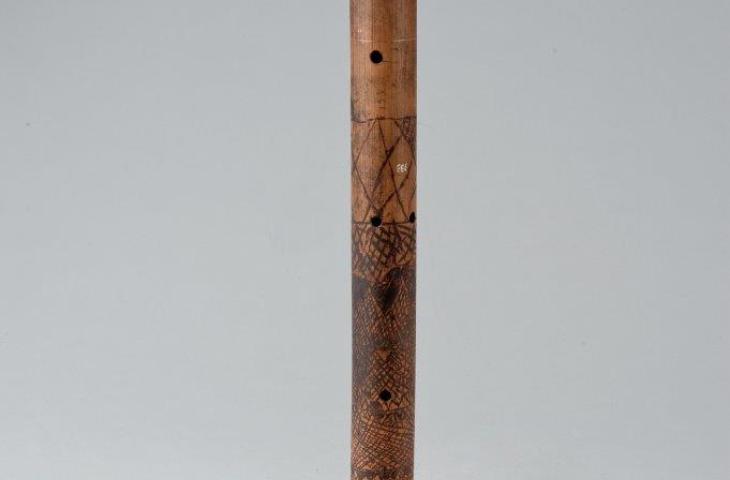July 2022
Fig.1

Fangufangu, Fiji Islands, before 1872 (03A13), inv.0133
Fig.2

Flute, New Caledonia, before 1878 (03A13), inv.0364
Fig.3

Kaleleng, Luzon (island of the Philippines), before 1975, deposit of Mr Fekke de Jager (29A11), inv. D2011.002.0015
Fig.4

Singapore. Sakay playing the Nose flute, postcard, Straits Settlements, after 1907, private collection
Fig.5

Philippine Islands: Young musicians playing the mouth and nose, postcard, Scheut Missionaries, after 1907, private collection.
Nasal flutes, blown through one nostril and not through the mouth as the name suggests, are found mainly in Southeast Asia and many islands in Oceania. While the musician blows with one nostril, he or she plugs the other with a finger or a plug made of plants. Now rare, abandoned or enjoying a revival, the traditional use of nasal flutes has often been discontinued or persists only among minority populations.
Some nasal flutes are made of a narrow bamboo inter-node. The node at one end has a small hole through which to blow. A variable number of playing holes are drilled along the tube, sometimes with a thumb hole. The flutes are decorated with incised or pyrographed engravings or left without any decoration.
Other flutes are blown through a hole drilled in the side, not far from the closed end of the pipe. A Fiji flute (inv. 0133), made of a large decorated bamboo internode, is representative of a model with several equally spaced holes, the outer holes of which can both be used for blowing. In practice, one direction of play is generally preferred by the musician.
While some of these flutes are certainly nasal flutes, others sometimes considered as nasal flutes are in fact blown through the mouth. Errors in Mahillon's inventory are due to the very incomplete and imprecise information at his disposal. These flutes are not mentioned here.
Sometimes there is doubt: is a flute a nasal flute or not? When the blowing hole is far from the end of the flute, the old photos are not very clear and do not allow to know the technique. Most of the old photos are posed and not taken on the spot, the musician does not really play and his gesture is ambiguous. The position of the flute and that of the musician do not make it possible to decide with certainty.
A long flute from New Caledonia (inv. 0364), made of an artificially curved reed with reinforced knots to avoid splitting, is probably not really a nasal flute. Mahillon acquired it at a world exhibition in Paris and considers it a nasal flute. There is very little literature on it and its use has been lost. Photographs of this type of instrument show the musician apparently with his mouth closed, but whose nose does not seem to be pressed against the flute either.
This flute has only one hole near each end: one for blowing, on the wider side, the other for changing the pitch.
Text: Claire Chantrenne